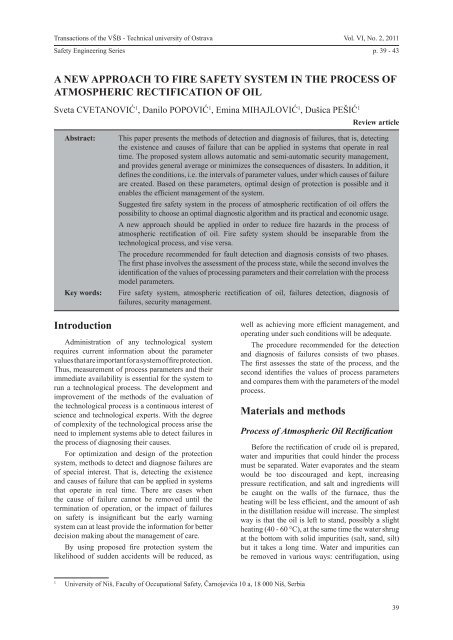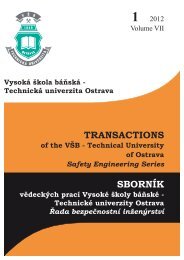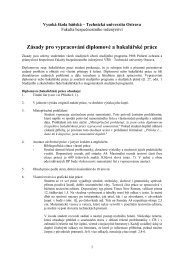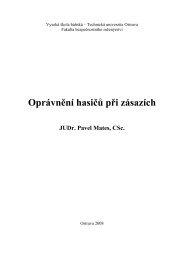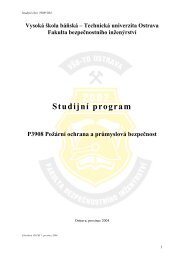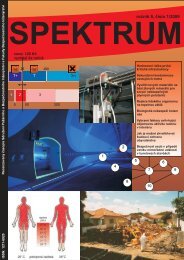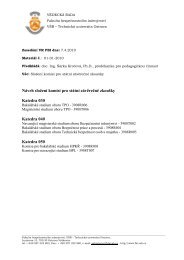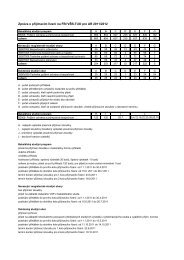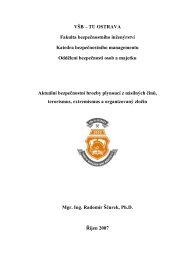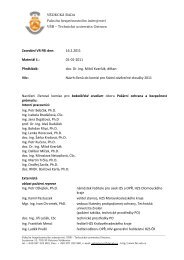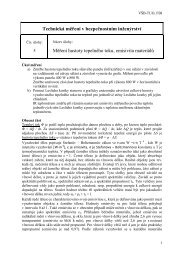Transactions - FBI - Vysoká Å¡kola báÅská - Technická univerzita ...
Transactions - FBI - Vysoká Å¡kola báÅská - Technická univerzita ...
Transactions - FBI - Vysoká Å¡kola báÅská - Technická univerzita ...
You also want an ePaper? Increase the reach of your titles
YUMPU automatically turns print PDFs into web optimized ePapers that Google loves.
<strong>Transactions</strong> of the VŠB - Technical university of OstravaSafety Engineering SeriesVol. VI, No. 2, 2011p. 39 - 43A NEW APPROACH TO FIRE SAFETY SYSTEM IN THE PROCESS OFATMOSPHERIC RECTIFICATION OF OILSveta CVETANOVIĆ 1 , Danilo POPOVIĆ 1 , Emina MIHAJLOVIĆ 1 , Dušica PEŠIĆ 1Review articleAbstract:Key words:This paper presents the methods of detection and diagnosis of failures, that is, detectingthe existence and causes of failure that can be applied in systems that operate in realtime. The proposed system allows automatic and semi-automatic security management,and provides general average or minimizes the consequences of disasters. In addition, itdefines the conditions, i.e. the intervals of parameter values, under which causes of failureare created. Based on these parameters, optimal design of protection is possible and itenables the efficient management of the system.Suggested fire safety system in the process of atmospheric rectification of oil offers thepossibility to choose an optimal diagnostic algorithm and its practical and economic usage.A new approach should be applied in order to reduce fire hazards in the process ofatmospheric rectification of oil. Fire safety system should be inseparable from thetechnological process, and vise versa.The procedure recommended for fault detection and diagnosis consists of two phases.The first phase involves the assessment of the process state, while the second involves theidentification of the values of processing parameters and their correlation with the processmodel parameters.Fire safety system, atmospheric rectification of oil, failures detection, diagnosis offailures, security management.IntroductionAdministration of any technological systemrequires current information about the parametervalues that are important for a system of fire protection.Thus, measurement of process parameters and theirimmediate availability is essential for the system torun a technological process. The development andimprovement of the methods of the evaluation ofthe technological process is a continuous interest ofscience and technological experts. With the degreeof complexity of the technological process arise theneed to implement systems able to detect failures inthe process of diagnosing their causes.For optimization and design of the protectionsystem, methods to detect and diagnose failures areof special interest. That is, detecting the existenceand causes of failure that can be applied in systemsthat operate in real time. There are cases whenthe cause of failure cannot be removed until thetermination of operation, or the impact of failureson safety is insignificant but the early warningsystem can at least provide the information for betterdecision making about the management of care.By using proposed fire protection system thelikelihood of sudden accidents will be reduced, aswell as achieving more efficient management, andoperating under such conditions will be adequate.The procedure recommended for the detectionand diagnosis of failures consists of two phases.The first assesses the state of the process, and thesecond identifies the values of process parametersand compares them with the parameters of the modelprocess.Materials and methodsProcess of Atmospheric Oil RectificationBefore the rectification of crude oil is prepared,water and impurities that could hinder the processmust be separated. Water evaporates and the steamwould be too discouraged and kept, increasingpressure rectification, and salt and ingredients willbe caught on the walls of the furnace, thus theheating will be less efficient, and the amount of ashin the distillation residue will increase. The simplestway is that the oil is left to stand, possibly a slightheating (40 - 60 °C), at the same time the water shrugat the bottom with solid impurities (salt, sand, silt)but it takes a long time. Water and impurities canbe removed in various ways: centrifugation, using1University of Niš, Faculty of Occupational Safety, Čarnojevića 10 a, 18 000 Niš, Serbia39


